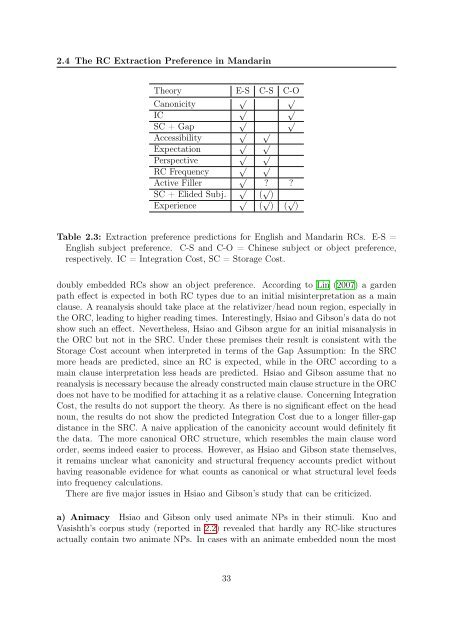Connectionist Modeling of Experience-based Effects in Sentence ...
Connectionist Modeling of Experience-based Effects in Sentence ...
Connectionist Modeling of Experience-based Effects in Sentence ...
You also want an ePaper? Increase the reach of your titles
YUMPU automatically turns print PDFs into web optimized ePapers that Google loves.
2.4 The RC Extraction Preference <strong>in</strong> Mandar<strong>in</strong><br />
Theory E-S C-S C-O<br />
√ √<br />
Canonicity<br />
√ √<br />
IC<br />
√ √<br />
SC + Gap<br />
√ √<br />
Accessibility<br />
√ √<br />
Expectation<br />
√ √<br />
Perspective<br />
√ √<br />
RC Frequency<br />
√<br />
Active Filler<br />
? ?<br />
SC + Elided Subj. √ ( √ )<br />
√ √ √<br />
<strong>Experience</strong><br />
( ) ( )<br />
Table 2.3: Extraction preference predictions for English and Mandar<strong>in</strong> RCs. E-S =<br />
English subject preference. C-S and C-O = Ch<strong>in</strong>ese subject or object preference,<br />
respectively. IC = Integration Cost, SC = Storage Cost.<br />
doubly embedded RCs show an object preference. Accord<strong>in</strong>g to L<strong>in</strong> (2007) a garden<br />
path effect is expected <strong>in</strong> both RC types due to an <strong>in</strong>itial mis<strong>in</strong>terpretation as a ma<strong>in</strong><br />
clause. A reanalysis should take place at the relativizer/head noun region, especially <strong>in</strong><br />
the ORC, lead<strong>in</strong>g to higher read<strong>in</strong>g times. Interest<strong>in</strong>gly, Hsiao and Gibson’s data do not<br />
show such an effect. Nevertheless, Hsiao and Gibson argue for an <strong>in</strong>itial misanalysis <strong>in</strong><br />
the ORC but not <strong>in</strong> the SRC. Under these premises their result is consistent with the<br />
Storage Cost account when <strong>in</strong>terpreted <strong>in</strong> terms <strong>of</strong> the Gap Assumption: In the SRC<br />
more heads are predicted, s<strong>in</strong>ce an RC is expected, while <strong>in</strong> the ORC accord<strong>in</strong>g to a<br />
ma<strong>in</strong> clause <strong>in</strong>terpretation less heads are predicted. Hsiao and Gibson assume that no<br />
reanalysis is necessary because the already constructed ma<strong>in</strong> clause structure <strong>in</strong> the ORC<br />
does not have to be modified for attach<strong>in</strong>g it as a relative clause. Concern<strong>in</strong>g Integration<br />
Cost, the results do not support the theory. As there is no significant effect on the head<br />
noun, the results do not show the predicted Integration Cost due to a longer filler-gap<br />
distance <strong>in</strong> the SRC. A naive application <strong>of</strong> the canonicity account would def<strong>in</strong>itely fit<br />
the data. The more canonical ORC structure, which resembles the ma<strong>in</strong> clause word<br />
order, seems <strong>in</strong>deed easier to process. However, as Hsiao and Gibson state themselves,<br />
it rema<strong>in</strong>s unclear what canonicity and structural frequency accounts predict without<br />
hav<strong>in</strong>g reasonable evidence for what counts as canonical or what structural level feeds<br />
<strong>in</strong>to frequency calculations.<br />
There are five major issues <strong>in</strong> Hsiao and Gibson’s study that can be criticized.<br />
a) Animacy Hsiao and Gibson only used animate NPs <strong>in</strong> their stimuli. Kuo and<br />
Vasishth’s corpus study (reported <strong>in</strong> 2.2) revealed that hardly any RC-like structures<br />
actually conta<strong>in</strong> two animate NPs. In cases with an animate embedded noun the most<br />
33
















